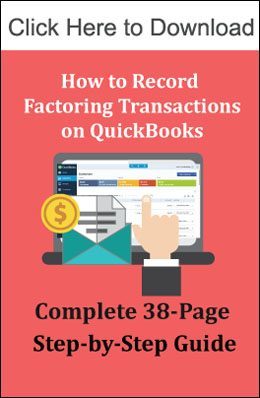Are you factoring receivables and need to record invoice factoring on QuickBooks?

We have compiled a comprehensive 38-page Step-by-Step Guide that includes everything you need to know about receivable factoring accounting in QuickBooks.
How To Record Factoring Entries
Our ”How to Record Invoice Factoring Transactions on QuickBooks” guide includes easy steps and instructional screenshots regarding the following topics:
Step 1 – Adding Required Accounts to the QuickBooks Chart of Accounts
A detailed explanation of all the accounts you’ll need to record A/R factoring transactions and instructions on adding them to the accounts chart.
Step 2- Selling Invoices to the Factoring Company
- Invoice purchased: Recording steps you’ll need to take when you sell accounts receivable to the factoring company.
- Factoring with Recourse: Specific entries you’ll need for recording the liability to the invoice factoring company if your company is factoring with recourse.
Step 3- Factored and Non-Factored Invoice Collection
- Factored Invoices: Data entry you’ll need to perform when your factoring company collects a factored invoice in the case of full and partial payments. It also includes instructions on recording discount fees paid to the factor.
- Non-Factored Invoices: QuickBooks entries required to record payments of non-factored receivables.
Step 4- Dealing with Uncollectible Factored Invoices
- Charge-backs: What accounting to do on QuickBooks when the factoring company charges you back uncollected amounts.
- Bad Debts: How to write off uncollectible debt from factored invoices depending if your company is:
- Factoring with or without recourse
- Uses Direct Write-off or Allowance for Doubtful Debts Methods to write-off uncollectible debt.
Step 5 – Recording Account Charges and Fees
- Factoring Expenses: How to record miscellaneous factoring account expenses such as mailing and wire fees.
- Factoring Administrative Fees: Steps to record administrative account fees charged by your factor, such as invoice factoring rates on outstanding balances.
Step 6 – Recording Reserve Releases
What to do when your factoring company releases amounts held in the reserve account and wires them into your company’s bank checking account.
Do you like the guide? Please share this page.
Do you have a different opinion on how factoring transactions should be recorded? We welcome comments and input on improving this guide’s content. Thanks in advance for your contributions.
More Resources


